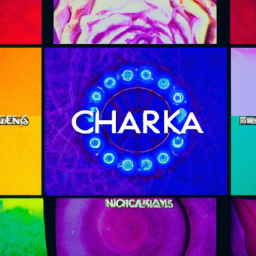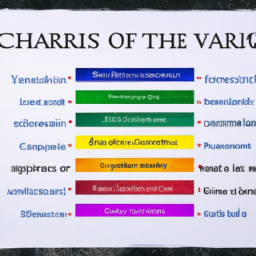Chakras, derived from the Sanskrit word for “wheel”, are energy centers located throughout the body. These centers are believed to be the pathways for the flow of vital energy, or prana, in and out of the body. The concept of chakras has been around for thousands of years in ancient Indian and Chinese medicine, and it is gaining more popularity in Western culture as a way to promote physical, emotional, and spiritual well-being.
There are seven main chakras that run along the spine, starting from the base and going up to the crown of the head. Each chakra is associated with a specific color, element, sound, and purpose. Understanding these chakras and their functions can help us achieve balance and harmony in our mind, body, and spirit.
Root Chakra (Muladhara)

The root chakra, located at the base of the spine, is associated with the color red and the element of earth. It represents our sense of grounding, stability, and survival instincts. When this chakra is balanced, we feel safe, secure, and grounded. However, if it is blocked, we may experience feelings of fear, insecurity, and instability.
To balance the root chakra, one can practice activities such as yoga, grounding exercises, and reconnecting with nature. Eating root vegetables, such as carrots and beets, can also help to activate this chakra.
Sacral Chakra (Svadhisthana)

The sacral chakra, located in the lower abdomen, is associated with the color orange and the element of water. It represents our creativity, sensuality, and emotions. When this chakra is balanced, we experience joy, pleasure, and emotional stability. However, if it is blocked, we may feel emotionally unstable or experience creative blocks.
To balance the sacral chakra, one can engage in creative activities, such as dancing or painting, and practice self-care and self-love. Eating orange foods, such as oranges and carrots, can also help to activate this chakra.
Solar Plexus Chakra (Manipura)

The solar plexus chakra, located in the upper abdomen, is associated with the color yellow and the element of fire. It represents our personal power, self-esteem, and confidence. When this chakra is balanced, we feel empowered and confident in our abilities. However, if it is blocked, we may feel a lack of self-worth and have difficulty making decisions.
To balance the solar plexus chakra, one can engage in activities that boost self-esteem and confidence, such as affirmations or positive self-talk. Eating yellow foods, such as bananas and corn, can also help to activate this chakra.
Heart Chakra (Anahata)

The heart chakra, located in the center of the chest, is associated with the color green and the element of air. It represents our ability to love and be loved, compassion, and forgiveness. When this chakra is balanced, we experience harmony and healthy relationships. However, if it is blocked, we may struggle with giving and receiving love or holding onto grudges.
To balance the heart chakra, one can practice acts of kindness, gratitude, and forgiveness. Practicing heart-opening yoga poses, such as camel pose or cobra pose, can also help to activate this chakra.
Throat Chakra (Vishuddha)

The throat chakra, located in the throat area, is associated with the color blue and the element of sound. It represents our ability to communicate, express ourselves, and speak our truth. When this chakra is balanced, we communicate clearly and effectively. However, if it is blocked, we may struggle with expressing ourselves or fear speaking our mind.
To balance the throat chakra, one can practice singing, chanting, or speaking affirmations aloud. Eating blue foods, such as blueberries or blue corn, can also help to activate this chakra.
Third Eye Chakra (Ajna)

The third eye chakra, located in the center of the forehead, is associated with the color indigo and the element of light. It represents our intuition, inner wisdom, and insight. When this chakra is balanced, we have a deeper understanding of ourselves and the world around us. However, if it is blocked, we may experience difficulty trusting our intuition or feeling disconnected from our inner self.
To balance the third eye chakra, one can practice meditation, visualization, and connecting with the inner self. Eating indigo foods, such as blueberries and purple grapes, can also help to activate this chakra.
Crown Chakra (Sahasrara)

The crown chakra, located at the top of the head, is associated with the color violet and the element of thought. It represents our connection to the divine, spiritual consciousness, and higher self. When this chakra is balanced, we have a sense of spiritual connection and purpose. However, if it is blocked, we may feel out of touch with our spirituality or lack direction in life.
To balance the crown chakra, one can engage in activities such as meditation, prayer, or connecting with nature. Eating violet foods, such as eggplants and purple carrots, can also help to activate this chakra.
A healthy and balanced chakra system can enhance our overall well-being and bring us a sense of harmony and inner peace. By understanding and working on these energy centers, we can unlock our fullest potential and lead a more fulfilling life.





Fascinating post! Thanks, CullenWatt!
I had no idea what chakras were – now I do!
#GreatPost! Impressive!